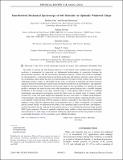| dc.contributor.author | Geri, Michela | |
| dc.contributor.author | Keshavarz, Bavand | |
| dc.contributor.author | Divoux, Thibaut | |
| dc.contributor.author | Clasen, Christian | |
| dc.contributor.author | Curtis, Daniel J. | |
| dc.contributor.author | McKinley, Gareth H. | |
| dc.date.accessioned | 2018-12-20T15:51:03Z | |
| dc.date.available | 2018-12-20T15:51:03Z | |
| dc.date.issued | 2018-12 | |
| dc.date.submitted | 2018-08 | |
| dc.identifier.issn | 2160-3308 | |
| dc.identifier.uri | http://hdl.handle.net/1721.1/119797 | |
| dc.description.abstract | The ability to measure the bulk dynamic behavior of soft materials with combined time and frequency resolution is instrumental for improving our fundamental understanding of connections between the microstructural dynamics and the macroscopic mechanical response. Current state-of-the-art techniques are often limited by a compromise between resolution in the time and frequency domains, mainly due to the use of elementary input signals that have not been designed for fast time-evolving systems such as materials undergoing gelation, curing, or self-healing. In this work, we develop an optimized and robust excitation signal for time-resolved mechanical spectroscopy through the introduction of joint frequency- and amplitude-modulated exponential chirps. Inspired by the biosonar signals of bats and dolphins, we optimize the signal profile to maximize the signal-to-noise ratio while minimizing spectral leakage with a carefully designed modulation of the envelope of the chirp, obtained using a cosine-tapered window function. A combined experimental and numerical investigation reveals that there exists an optimal range of window profiles (around 10% of the total signal length) that minimizes the error with respect to standard single-frequency sweep techniques. The minimum error is set by the noise floor of the instrument, suggesting that the accuracy of an optimally windowed-chirp (OWCh) sequence is directly comparable to that achievable with a standard frequency sweep, while the acquisition time can be reduced by up to 2 orders of magnitude, for comparable spectral content. Finally, we demonstrate the ability of this optimized signal to provide time- and frequency-resolved rheometric data by studying the fast gelation process of an acid-induced protein gel using repeated OWCh pulse sequences. The use of optimally windowed chirps enables a robust time-resolved rheological characterization of a wide range of soft materials undergoing rapid mutation and has the potential to become an invaluable rheometric tool for researchers across different disciplines. | en_US |
| dc.publisher | American Physical Society | en_US |
| dc.relation.isversionof | http://dx.doi.org/10.1103/PhysRevX.8.041042 | en_US |
| dc.rights | Creative Commons Attribution | en_US |
| dc.rights.uri | http://creativecommons.org/licenses/by/3.0 | en_US |
| dc.source | American Physical Society | en_US |
| dc.title | Time-Resolved Mechanical Spectroscopy of Soft Materials via Optimally Windowed Chirps | en_US |
| dc.type | Article | en_US |
| dc.identifier.citation | Geri, Michela et al. "Time-Resolved Mechanical Spectroscopy of Soft Materials via Optimally Windowed Chirps." Physical Review X 8, 4 (December 2018): 041042 | en_US |
| dc.contributor.department | Massachusetts Institute of Technology. Department of Mechanical Engineering | en_US |
| dc.contributor.mitauthor | Geri, Michela | |
| dc.contributor.mitauthor | Keshavarz, Bavand | |
| dc.relation.journal | Physical Review X | en_US |
| dc.eprint.version | Final published version | en_US |
| dc.type.uri | http://purl.org/eprint/type/JournalArticle | en_US |
| eprint.status | http://purl.org/eprint/status/PeerReviewed | en_US |
| dc.date.updated | 2018-12-06T18:00:25Z | |
| dc.language.rfc3066 | en | |
| dspace.orderedauthors | Geri, Michela; Keshavarz, Bavand; Divoux, Thibaut; Clasen, Christian; Curtis, Daniel J.; McKinley, Gareth H. | en_US |
| dspace.embargo.terms | N | en_US |
| dc.identifier.orcid | https://orcid.org/0000-0002-6393-5378 | |
| dc.identifier.orcid | https://orcid.org/0000-0002-1988-8500 | |
| mit.license | PUBLISHER_CC | en_US |
